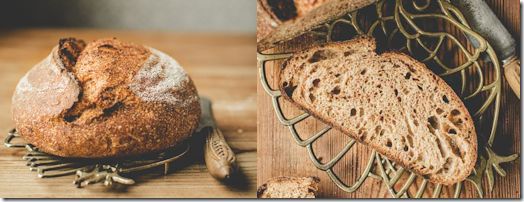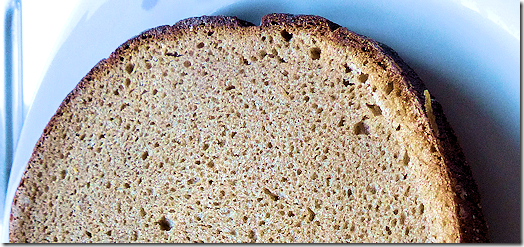 Like most of us, I have a lot of spare time on my hands right now, and regular readers will know that I like cooking, especially if it involves trying to copy something that already exists commercially, and which I enjoy eating.
Like most of us, I have a lot of spare time on my hands right now, and regular readers will know that I like cooking, especially if it involves trying to copy something that already exists commercially, and which I enjoy eating.
Note: This is a three-part series – the fun stuff is in Parts II and III.
Before the lockdown, I rediscovered something I’ve missed for years – German Rye Bread. And I mean the proper sourdough rye – not Hovis or any other insipid ‘wholemeal’ concoction that’s just packet white bread with some brown dye in it.
Thinking back to whenever I travelled abroad with someone on business (even when I used to go on skiing trips with friends, for that matter), once we got there food was always a problem. There was always someone in the bloody group who would only want to eat burgers or pizza – and even that threw up issues if the burger wasn’t a McDonalds, and the fact that proper continental pizza is nothing like a Dominos or Pizza Hut affair.
‘Tough, we’re having Bratwurst and Sauerkraut’ tended not to go down too well, so there was little choice but to give in at least some of the time. You see, if I’m in France, I eat croissants, proper baguettes, and anything else French. And I love it. It’s the same if I’m in America, Pakistan (a bit risky), Switzerland, Spain, Austria, Italy, or Germany. I mean, what’s the point of being up in the Alps or The Dolomites, with the smell of wood fires and fresh coffee all around, and you’ve got to walk miles to the end of the village to get a bloody McDonalds (and Coke) for a fussy eater? One time, at a conference in Vienna with this guy (it was close to Christmas, with all the Christmas markets over there, to make matters worse), we’d agreed to alternate on who decided where we ate each evening. As the one of us who wasn’t afraid to look around and embarrass himself trying to speak German (I can, a bit), and who preferred continental beer to Fosters at the best of times, the first night I found a place where they didn’t speak any English, served brilliant Austrian food (Wiener schnitzel, strudel, spätzle, and so on), beer in Steins, and and which was where all the locals went to eat. Next night, the guy I was with wanted to go for a bloody Chinese! I was seething – we’re in Vienna, at Christmas, with all the Sachertorte and Apfelstrudel in those markets, and instead we’re eating Crispy bleeding Duck (he was being ‘adventurous’) in a plastic Chinese restaurant that was exactly the same as back home.
I’ve always had a soft spot for Germany, though, and the last few times I was there – while those I was with would grumble and gingerly poke at a bowl of non-British cornflakes with non-British milk (or maybe a croissant with non-British jam) for breakfast, in prelude to the nightly argument over whether we’d go for Schweinshaxe followed by Germknödel or a McDonalds that evening – I’d go for the full-on German option of scrambled eggs and a selection of different and often very dark breads, with various cooked meats, salamis, and cheeses. I fell in love with German bread more each time I went (as well as Germknödel). Incidentally, if ever you go to Hanover, look up The Bavarium restaurant – brilliant Gulaschsuppe and (sigh) Germknödel.
Anyway, back to the point. I had found proper German rye bread in Asda, of all places – made and packed over there. It was just rye bread, too, and not that poncey stuff with sunflower seeds, or nuts and raisins in it, and usually with a bloody rainbow on the wrapper somewhere. Nor did it specifically mention ‘for vegans and other weirdoes’ on the wrapper. It was just as I remembered, but being unfortunately situated on the special weirdo shelf in Asda’s bakery section, it was often sold out. As a result, I bought it when I could and froze it – being so dense, it freezes perfectly. Then came the lockdown, Asda doesn’t sell it online, nor can I find it anywhere else.
In the early stages of the lockdown it was impossible to get any bread from Asda at all thanks to the panic-buyers. My elderly parents only eat white bread and my dad, in particular, is a stubborn old sod and won’t accept that we need to make do with what we can actually get, rather than pick and choose what we want. My first thought was ‘Breadmaking Machine’, but I immediately discovered that the panic-buyers had cleared those off the shelves (and online). Then I realised they’d cleared out all the stocks of yeast and flour, too.
Things have calmed down a bit with Asda, though it’s still hit-and-miss, and getting white bread for my parents is somewhat easier. But I wanted German Rye, so out came my project hat, and off I went to resolve the issue.
Googling threw up a multitude of ‘authentic’ German recipes, all of which were as authentic as a Corsa with a BMW badge glued to it. Anything which contains ‘all-purpose flour’ is not authentic. It’s American. Any ‘sourdough’ recipe calling for ‘instant yeast’ is the same. And Americans seem to have this weird fascination with making bread with silly patterns on the crust, and the biggest imaginable holes in it so they can boast how much it has risen in multitudes of ‘rustic’ photographs. Yet this was all that kept coming up.
Then I realised what I was doing wrong, and fired up my trusty VPN to pretend I was in Germany. That did it! Stacks of German recipes, from Germany, and in German. Armed with my fluent (in my dreams) German linguistic skills – and Google Translate – I figured out how I was going make Vollkornbrot to begin with.
As I already implied, there must be thousands of nutcases all over the UK right now who are sitting on stockpiles of every type of flour, yeast, and electrical appliance that could even remotely be used in baking bread, without having a clue how to use any of them. But, when in Rome – or in the case of my VPN, Germany – I decided to order from German millers. So I now have 10kg of rye flour (Roggenmehl) and a couple of kg of coarse rye meal (Roggenschot). Roggen means ‘rye’, Mehl means ‘flour’, Roggenschot literally means ‘rye scrap’ or ‘rye flour’ (but coarsely ground), and Vollkornbrot means ‘whole grain bread’.
Sourdough (Sauerteig in German) bread doesn’t use any added yeast. Instead, you have a starter culture (Anstellgut), which utilises the natural yeasts present in the flour. To make one, you simply mix flour and water, and over a number of days gradually coax the yeast into becoming more and more active by adding more flour and water until it is at a level of activity where it can be used to give the necessary rise to your bread. As long as you keep feeding it, the starter lasts pretty much forever (some bakeries boast starters which are over 100 years old), and you only use a fraction of it each time you make bread. More about this in Part II.
 My target is something with a tight crumb similar to this (the stuff I was buying from Asda). No stupid 3cm wide holes, and no Leonardo da Vinci crap on the crust. Just a dense rye bread.
My target is something with a tight crumb similar to this (the stuff I was buying from Asda). No stupid 3cm wide holes, and no Leonardo da Vinci crap on the crust. Just a dense rye bread.
Part II of this series will make the starter/Anstellgut, and Part III will be the baking of my first loaf of Vollkornbrot.
And trust me on this. It might seem like a lot of hassle, but it isn’t. Once you have your starter – which isn’t time consuming other than the day wait between stages – making bread is an absolute, laid-back doddle.